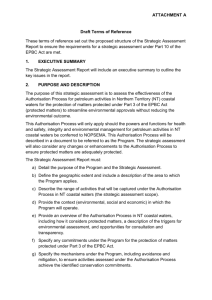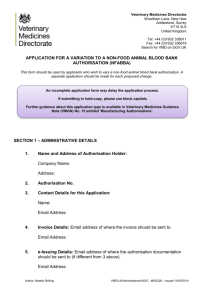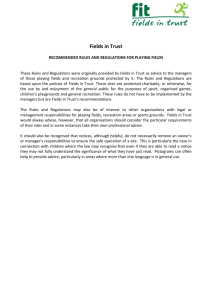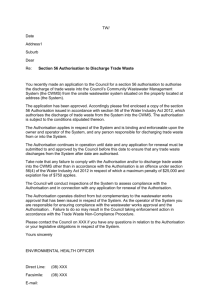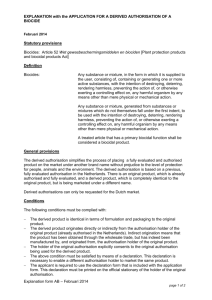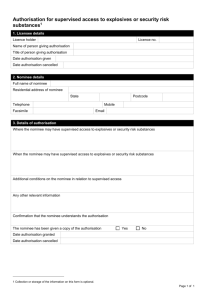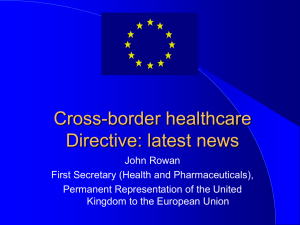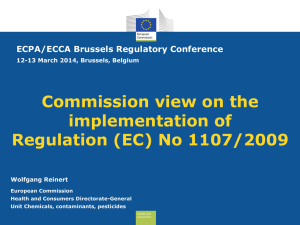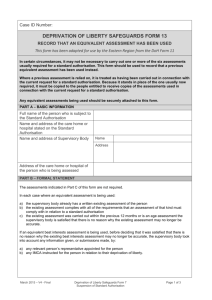Final Terms of Reference
advertisement
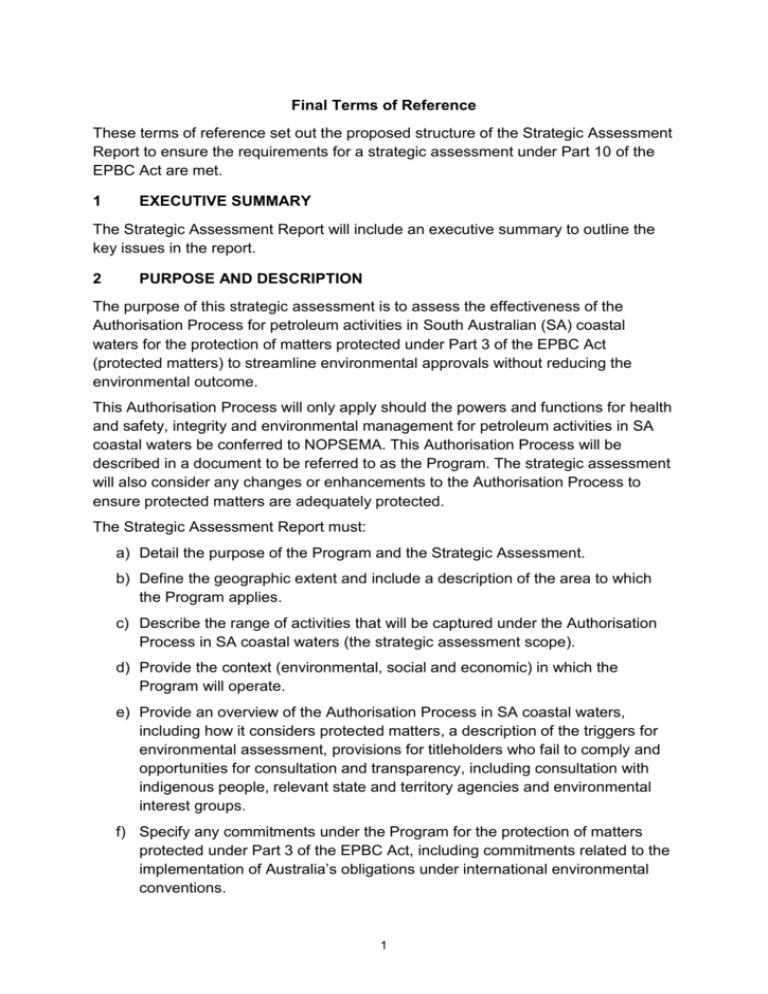
Final Terms of Reference These terms of reference set out the proposed structure of the Strategic Assessment Report to ensure the requirements for a strategic assessment under Part 10 of the EPBC Act are met. 1 EXECUTIVE SUMMARY The Strategic Assessment Report will include an executive summary to outline the key issues in the report. 2 PURPOSE AND DESCRIPTION The purpose of this strategic assessment is to assess the effectiveness of the Authorisation Process for petroleum activities in South Australian (SA) coastal waters for the protection of matters protected under Part 3 of the EPBC Act (protected matters) to streamline environmental approvals without reducing the environmental outcome. This Authorisation Process will only apply should the powers and functions for health and safety, integrity and environmental management for petroleum activities in SA coastal waters be conferred to NOPSEMA. This Authorisation Process will be described in a document to be referred to as the Program. The strategic assessment will also consider any changes or enhancements to the Authorisation Process to ensure protected matters are adequately protected. The Strategic Assessment Report must: a) Detail the purpose of the Program and the Strategic Assessment. b) Define the geographic extent and include a description of the area to which the Program applies. c) Describe the range of activities that will be captured under the Authorisation Process in SA coastal waters (the strategic assessment scope). d) Provide the context (environmental, social and economic) in which the Program will operate. e) Provide an overview of the Authorisation Process in SA coastal waters, including how it considers protected matters, a description of the triggers for environmental assessment, provisions for titleholders who fail to comply and opportunities for consultation and transparency, including consultation with indigenous people, relevant state and territory agencies and environmental interest groups. f) Specify any commitments under the Program for the protection of matters protected under Part 3 of the EPBC Act, including commitments related to the implementation of Australia’s obligations under international environmental conventions. 1 g) Specify the mechanisms under the Program, including avoidance and mitigation, to ensure activities assessed under the Authorisation Process achieve the identified conservation commitments. h) An overview of how the strategic assessment will maximise regulatory efficiency, while retaining strong environmental safeguards. 3 MATTERS PROTECTED UNDER PART 3 OF THE EPBC ACT 3.1 Identification of Protected Matters The Strategic Assessment Report must address how the Authorisation Process meets the objects of the EPBC Act and protects the following protected matters: 3.2 World Heritage properties(sections 12 and 15A) National Heritage places (sections 15B and 15C) Ramsar wetlands (sections 16 and 17B) Listed threatened species and communities (sections 18 and 18A) Listed migratory species (sections 20 and 20A) Commonwealth marine areas (sections 23 and 24A) Commonwealth land (sections 26 and 27A). Identification and analysis of potential impacts The Strategic Assessment Report must identify and analyse the likely direct and indirect impacts of activities assessed and authorised under the Program on protected matters within the area described in the Program, and against the desired conservation outcomes identified in the Program. The Strategic Assessment Report must include an analysis of the way that the Program will assess: a) The nature of the potential range of activities and a description of the types of impacts considered, including cumulative impacts; and b) The potential impacts on protected matters and those aspects of the environment considered critical to the continued presence and functioning of protected matters. 3.3 Measures to avoid, mitigate and adaptively manage impacts The Program must identify specific measures that have been, or will be, implemented to ensure that petroleum activities assessed under the Program avoid and mitigate impacts on protected matters, including: a) requirements under the Authorisation Process for proponents to avoid, mitigate and adaptively manage impacts where direct or indirect impacts are expected or likely. 2 3.4 Identification and analysis of the Authorisation Process The Strategic Assessment Report must include: a) a comparison of the Authorisation Process and regulatory requirements of the EPBC Act for protection of protected matters in SA coastal waters, including the referral, assessment and approvals regime under Chapter 4, and compliance and regulatory regimes. This includes showing, for example through process mapping: 1. how the Authorisation Process identifies and assesses potential impacts on protected matters in SA coastal waters, including how the Authorisation Process requires proponents to: i. Describe the nature of proposed petroleum activities and the baseline environment. ii. Provide a description of type and likelihood of risks considered and conduct a risk assessment to evaluate the potential risks and prepare appropriate response strategies that adequately address protected matters. iii. Implement an approach that firstly seeks to avoid impacts on protected matters, and then seeks to mitigate residual impacts. iv. Apply relevant policies, industry practices and administrative guidelines for the protection of protected matters, including existing policy statements, Recovery Plans, Conservation Advices, Threat Abatement Plans, Marine Bioregional Plans, Commonwealth Marine Reserve Management Plans, and other relevant Australian Government Documents. v. Undertake appropriate and timely public consultation commensurate to the activity. vi. Address direct, indirect and cumulative impacts of activities assessed and authorised by NOPSEMA in SA coastal waters. vii. Describe the baseline environment, and consider the other long term influences, including the potential cumulative impacts and impacts of climate change, that may also impact on protected matters in the receiving environment (for example, including information available from the public domain). 2. how the impact assessment process under the EPBC Act, including relevant policies and guidelines, identifies and assesses potential impacts on protected matters 3. how the Authorisation Process and the EPBC Act process incorporate transparency and public consultation processes during the assessment process and decision making 3 b) Consideration of the Authorisation Process against formal accreditation standards which may be developed by the Department of the Environment, if appropriate. c) Any specific changes or amendments to be made to regulations or regulatory policies to meet the requirements of the EPBC Act and ensure adequate protection of protected matters, and an assessment of the likely effectiveness and outcomes of these changes. d) An analysis of the effectiveness of the Authorisation Process in protecting protected matters in SA coastal waters, including associated regulatory and policy arrangements to implement commitments. e) Identification of other relevant authorities (including state and territory authorities) responsible for the implementation of key recommendations, if any. 4 PROMOTING ECOLOGICALLY SUSTAINABLE DEVELOPMENT The Strategic Assessment Report must identify how the principles of ecologically sustainable development (section 3A of the EPBC Act) are applied in the Authorisation Process and how the process will ensure proponents will continue to implement/improve these principles. 5 ADAPTIVE MANAGEMENT: ADDRESSING UNCERTAINTY AND MANAGING RISK The Strategic Assessment Report must identify how the Authorisation Process requires proponents to demonstrate: a) The degree to which adaptive management strategies would be implemented for activities authorised under the Authorisation Process to ensure protected matters are effectively protected to address uncertainties and inherent risks where they arise in proposed petroleum activities. Uncertainties could, for example, include knowledge gaps in scientific understanding and changing thresholds of acceptability for noise and other impacts. b) How monitoring of protected matters will be addressed through approved implementation strategies to achieve the desired conservation outcomes. c) How the monitoring will be analysed throughout the life of the Authorisation Process and how the results of the monitoring will inform adaptive management in the Authorisation Process. d) How new information relating to protected matters, including new listings under the EPBC Act, will be addressed through the Authorisation Process. The Strategic Assessment Report must also detail NOPSEMA’s compliance monitoring processes for these outcomes. 4 6 AUDITING AND REPORTING The Strategic Assessment Report must set out how: a) The Authorisation Process requires NOPSEMA to undertake monitoring and auditing, including any third party auditing of proponents, and public reporting of results. b) NOPSEMA uses monitoring and auditing results to ensure ongoing improvement within the Authorisation Process. c) NOPSEMA reports on its regulatory responsibilities and demonstrates accountability. 7 REVIEW OR MODIFICATION OF PROGRAM The Strategic Assessment Report must identify and analyse the likely circumstances and procedures that may result in the review or modification of the Program if it is endorsed, and how endorsement would be maintained. 8 REFERENCES AND INFORMATION SOURCES The Strategic Assessment Report will include a list of references. For information and data used in the assessment, the Strategic Assessment Report must state: a) the source and currency (date) of the information b) the reliability and limitations of the information. 5
